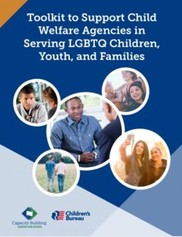|
Supporting LGBTQI+ children and youth in their sexual orientation, gender identity and expression (SOGIE) provides significant mental health protection for this vulnerable population. According to a recent survey, 42 percent of LGBTQI+ youth seriously considered attempting suicide in the past year, including more than half of transgender and nonbinary youth; LGBTQI+ youth who were subjected to conversion therapy reported more than twice the rate of attempting suicide in the past year compared to those who were not[1].
Conversely, the same survey also indicated that transgender and nonbinary youth who had their identities affirmed by those they lived with (e.g., having their pronouns respected and being able to change them on legal documents) and LGBTQI+ youth who had access to spaces that affirmed their identities attempted suicide at substantially lower rates[2].
These data and others clearly demonstrate the importance of affirming and supporting children and youth who are LGBTQI+ or who have a nonconforming gender identity or expression in their identities while in foster care[3]. The Children’s Bureau strongly recommends that agencies be intentional about assessing the needs of each LGBTQI+ child and youth, including those related to their mental and physical health[4].
Why This Is Important
To better understand why agencies need to focus on supporting and affirming LGBTQI+ children and youth in their identities, consider the following:
- LGBTQI+ youth are 1.5 to 2 times more likely than their peers to be living in foster care. They also experienced increased rates of physical violence and emotional harm both prior to being involved with and while in the child welfare system[5].
- LGBTQI+ young adults who reported high levels of family rejection during adolescence were 5.9 times more likely to report high levels of depression and 3.4 times more likely to use illegal drugs compared with peers from families that reported no or low levels of family rejection[6].
- LGBTQI+ youth of color and transgender teenagers experience unique challenges and elevated stress. Only 11 percent of youth of color surveyed believe their racial or ethnic group is regarded positively in the U.S., and over 50 percent of trans and gender expansive youth said they can never use school restrooms that align with their gender identity[7].
Consider how the following actions can work to create a foundation of support for LGBTQI+ children and youth at your agency:
- Listen and affirm what LGBTQI+ children and youth tell you about their identities, including their preferred pronouns, names, and other information.
- Provide foster placements where LGBTQI+ children and youth will be supported. Evidence is clear that LGBTQI+ children and youth in foster care are most likely to thrive in safe, affirming environments.
- Offer LGBTQI+ children and youth access to mental and other health care that affirms their identities and make sure that they are receiving it.
- Pay attention to the additional challenges faced by LGBTQI+ children and youth with intersectional identities (e.g., being both LGBTQI+ and nonwhite, immigrant, or non-English speaking) and offer support to mitigate them.
Resources developed by the Center for States and other federal partners can help your agency build capacity to support LGBTQI+ children and youth and help them thrive by improving practice, developing inclusive policies, and creating a culture that affirms LGBTQI+ identities.
Publications
|
|
 |
Archived Webinars
|
|
 |
Related Resources
Related Organizations
-
Child Welfare Information Gateway – promotes the safety, permanency, and well-being of children, youth, and families by connecting child welfare, adoption, and related professionals as well as the public to information, resources, and tools covering topics such as child welfare, child abuse and neglect, out-of-home care, adoption, and more.
-
Substance Abuse and Mental Health Services Administration (SAMHSA) –leads public health efforts to advance the behavioral health of the nation, including reducing the impact of substance abuse and mental illness on America's communities. SAMHSA offers resources on the LGBTQ+ population including national survey reports, agency and federal initiatives, and related behavioral health resources.
Did you receive this message from a friend? Get it delivered to your inbox.
|